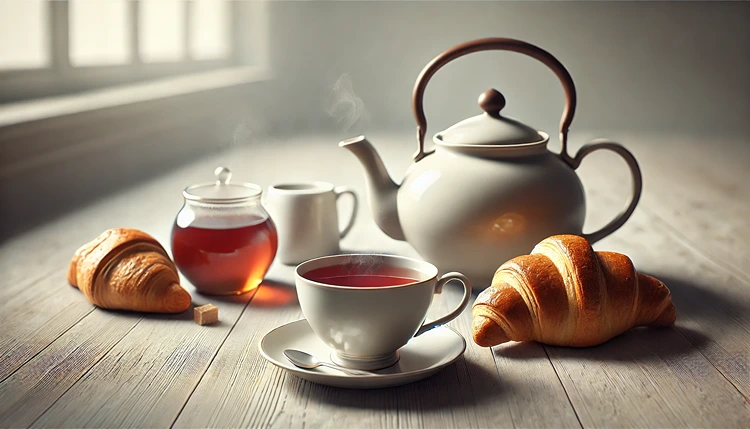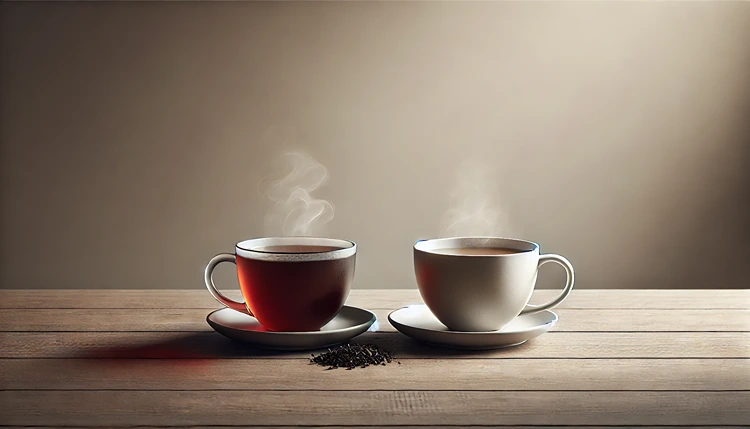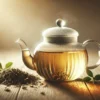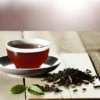When it comes to black tea, Earl Grey and English Breakfast are two of the most popular choices. But if you’ve ever wondered, “Which one is stronger?”—you’re not alone. This question can pop up whether you’re choosing a morning pick-me-up or a cozy afternoon tea. The answer isn’t as straightforward as you might think because strength can mean different things: caffeine content, flavor intensity, or even how the tea leaves are blended. Let’s break it all down and explore which tea might best suit your needs.
What Is Earl Grey Tea?
Earl Grey is one of those teas that stands out for its unique, fragrant aroma. What makes it different? It’s infused with oil from the rind of the bergamot orange, a citrus fruit that adds a distinct floral and slightly sweet flavor. The base of Earl Grey is usually a black tea, but sometimes you’ll find variations with green or oolong teas. The most common base, though, is black tea, which contributes to its depth and strength.
Helpful Hint:
If you’re sensitive to caffeine, try looking for Earl Grey made with a green tea base. It offers the same citrusy flavor with less caffeine punch.
What Is English Breakfast Tea?
English Breakfast is more straightforward than Earl Grey. It’s a robust, full-bodied black tea known for its rich, malty flavor. This tea was traditionally created to be paired with a hearty breakfast (hence the name), but it’s also enjoyed throughout the day. English Breakfast is often a blend of black teas, usually from Assam, Ceylon, and sometimes Kenyan varieties. Because of this blend, it has a bold taste that can hold its own even when paired with milk and sugar.
Which Tea Has More Caffeine?
One way to define “stronger” is by looking at caffeine content. Both Earl Grey and English Breakfast teas are black teas, so they naturally contain caffeine. However, the exact caffeine level can vary depending on the type of black tea used and how long it’s steeped.
- Earl Grey: Typically, it has slightly less caffeine than English Breakfast, especially if the blend includes lighter teas like Darjeeling.
- English Breakfast: Often made with stronger teas like Assam, it tends to have more caffeine, giving it an extra boost.
So, if you’re looking for a tea to give you more energy, English Breakfast might be your go-to option. However, if you’re sensitive to caffeine but still want a black tea, Earl Grey could be the better choice.
Which Tea Has a Stronger Flavor?
Now let’s talk about flavor. Both teas are black, but their flavors are distinct.
Earl Grey’s Flavor
The flavor of Earl Grey is more complex due to the addition of bergamot oil. The citrusy notes stand out and give the tea a refreshing, light taste despite its black tea base. Some people describe it as floral, while others note the slight bitterness from the bergamot. Overall, it’s a tea that’s strong in aroma but gentler in taste compared to English Breakfast.
English Breakfast’s Flavor
English Breakfast, on the other hand, is known for its robust, malty flavor. It’s the kind of tea that feels strong and hearty, making it an excellent match for breakfast foods like toast, eggs, or pancakes. The lack of additional flavors like bergamot means you get a more direct and intense black tea experience.
If you’re aiming to get the strongest possible brew, there are a few tips to follow for each tea. Both teas benefit from a longer steeping time, but you’ll want to be careful not to overdo it, as that can lead to bitterness.
How to Brew a Strong Cup of Earl Grey
Ingredients
- 1 teaspoon Earl Grey loose-leaf tea (or 1 tea bag)
- 1 cup boiling water (around 200°F)
- Optional: milk, sugar, or lemon
Instructions
- Bring water to a boil and let it cool slightly to around 200°F.
- Add the tea leaves to your cup or teapot.
- Pour the hot water over the tea and let it steep for 3-5 minutes, depending on how strong you want it.
- Remove the tea leaves or bag and enjoy as-is, or add milk, sugar, or lemon for extra flavor.
How to Brew English Breakfast
How to Brew a Strong Cup of English Breakfast
Ingredients
- 1 teaspoon English Breakfast loose-leaf tea (or 1 tea bag)
- 1 cup boiling water (around 212°F)
- Optional: milk and sugar
Instructions
- Boil water to around 212°F.
- Add the tea leaves to your cup or teapot.
- Pour the boiling water over the tea and let it steep for 4-5 minutes.
- Remove the tea leaves or bag, then add milk and sugar if desired.
For both teas, steeping time is key to getting the strongest flavor and most caffeine. The longer you steep, the more intense the tea will be. Just keep an eye on it to avoid any unwanted bitterness!
Key Differences Between Earl Grey and English Breakfast
| Aspect | Earl Grey | English Breakfast |
|---|---|---|
| Flavor Profile | Fragrant, citrusy with bergamot oil | Bold, malty, rich black tea flavor |
| Caffeine Content | 40-70 mg per cup | 50-90 mg per cup |
| Best Pairings | Lemon desserts, light pastries | Toast, eggs, hearty breakfast foods |
| Best Time to Drink | Afternoon, after meals | Morning, with breakfast |
| Base Tea | Black tea (usually Assam or Ceylon) | Blend of black teas (Assam, Ceylon, Kenyan) |
Which Tea Should You Choose?
If you’re still torn between Earl Grey and English Breakfast, it really comes down to your personal taste and what you’re looking for in a tea.
- Choose Earl Grey if: You enjoy a tea with a fragrant, citrusy aroma and a lighter, more floral taste. It’s great if you want something a bit different from your regular black tea.
- Choose English Breakfast if: You prefer a bold, strong tea that pairs well with milk and sugar. It’s ideal for mornings or when you need an energy boost.
Flavor Profiles: Earl Grey vs English Breakfast
One of the key differences between Earl Grey and English Breakfast lies in their flavor profiles. Both teas are black teas at their core, but the addition of bergamot oil in Earl Grey changes the game. Let’s break down the taste experience of each tea, so you know exactly what to expect when you brew a cup.
What Does Earl Grey Taste Like?
The moment you brew Earl Grey, the aroma of citrus and florals hits you immediately. The flavor is fragrant, thanks to the bergamot oil, which gives it that slightly perfumed, citrusy note. If you’re not familiar with bergamot, imagine a cross between a lemon and an orange, but with a slightly floral edge. This aromatic quality makes Earl Grey feel lighter and more complex compared to other black teas.
The tea base itself, usually a blend of Assam or Ceylon, brings the boldness and depth of black tea, but the bergamot tempers it, making it a more delicate and refreshing option. Some describe Earl Grey as slightly bitter, but the citrus notes often balance that out. Overall, the flavor profile of Earl Grey is layered—citrus, floral, with the underlying strength of black tea.
What Does English Breakfast Taste Like?

English Breakfast tea, on the other hand, is the embodiment of classic, robust black tea. It’s malty, full-bodied, and rich. Because English Breakfast is often a blend of different black teas—such as Assam, Ceylon, and Kenyan—the taste can vary depending on the brand or blend you choose. However, it consistently delivers a strong and assertive flavor that holds up well to milk and sugar, which is why it’s a breakfast staple.
The flavor of English Breakfast is straightforward compared to Earl Grey. There’s no added citrus or floral components; just pure, malty black tea. It’s the kind of tea that provides a satisfying punch, which is perfect for mornings when you need a strong cup to get your day started. If you like your tea bold and unadorned, English Breakfast is the way to go.
Which Tea Is Stronger in Terms of Flavor?
Now, here’s where things get subjective. “Strength” can mean different things to different people. If we’re talking about bold, punchy flavor, English Breakfast is the stronger tea. It’s designed to be full-bodied, and its flavor profile is meant to stand out, even when you add milk and sugar.
Earl Grey, on the other hand, is more delicate, with complex layers of flavor. While it may not be as bold as English Breakfast, the addition of bergamot makes it unique and fragrant. Some might say Earl Grey’s strength lies in its distinctive flavor rather than in its boldness. So, if you prefer a lighter tea with more nuanced flavors, you might find Earl Grey to be “stronger” in terms of its complexity and aroma.
How to Choose Between Earl Grey and English Breakfast
Choosing between Earl Grey and English Breakfast depends on your taste preferences and what you want out of your tea experience. Here are a few scenarios to help guide your decision:
- If you’re a fan of citrusy flavors: Earl Grey’s bergamot flavor will be right up your alley. The light, refreshing notes of citrus can be a nice change from the more traditional flavors of black tea.
- If you want a tea that pairs well with breakfast: English Breakfast is the clear winner. Its bold flavor holds up well to food, making it the perfect companion to toast, eggs, or pastries.
- If you prefer a tea that’s complex but not too strong: Earl Grey’s floral and citrus notes make it an elegant choice for those who want a black tea without the heaviness of something like English Breakfast.
- If you need a caffeine boost: English Breakfast tends to have a slightly higher caffeine content, making it the stronger option if you’re looking for energy.
How Do Earl Grey and English Breakfast Pair with Food?
Tea is often enjoyed alongside food, and both Earl Grey and English Breakfast have their ideal pairings. Whether you’re a fan of sweet treats or savory meals, knowing how to match your tea with food can elevate your experience.
What to Pair with Earl Grey Tea
Earl Grey’s light, citrusy flavor makes it a fantastic match for delicate desserts. Think pastries, scones, or light cakes. The floral notes of the bergamot also complement sweeter flavors like vanilla or fruit. Some excellent food pairings for Earl Grey include:
- Lemon-flavored desserts like lemon cake or lemon bars
- Scones with clotted cream and jam
- Shortbread cookies
- Fruit tarts
Earl Grey can also be enjoyed with savory dishes, especially those with a citrus or herb-based component, like salads with a citrus vinaigrette or herbed finger sandwiches.
What to Pair with English Breakfast Tea
Given its robust and malty flavor, English Breakfast pairs well with heartier, savory foods. It’s traditionally enjoyed with breakfast foods, but it also works great with baked goods and snacks that have bold flavors. Some classic food pairings for English Breakfast include:
- Toast with butter and jam
- Eggs, bacon, or sausage
- Hearty sandwiches or wraps
- Croissants or savory scones
If you’re a fan of adding milk and sugar to your tea, English Breakfast is versatile enough to handle the richness without losing its character. It’s a tea that stands its ground even when paired with filling meals.
Which Is Stronger: Caffeine Content of Earl Grey vs English Breakfast
If you’re drinking tea for the caffeine boost, it’s important to know how Earl Grey and English Breakfast compare in terms of caffeine content. While both are black teas and naturally contain caffeine, the levels can vary depending on the blend.
Earl Grey Caffeine Content
The caffeine content of Earl Grey depends on the type of black tea used as the base. Since it’s often a blend of Assam or Ceylon, the caffeine levels are moderate, usually ranging between 40-70 mg per cup. However, because of the bergamot oil, Earl Grey can sometimes feel less intense, even though it still offers a good caffeine kick.
English Breakfast Caffeine Content
English Breakfast tends to be on the higher end of the caffeine spectrum. Since it often uses stronger teas like Assam, its caffeine content can range from 50-90 mg per cup. If you need a solid boost of energy in the morning, English Breakfast is typically the better choice.
Keep in mind that the actual caffeine level depends on factors like the tea brand, how long you steep it, and the quantity of tea leaves used. If you’re particularly sensitive to caffeine, opt for a shorter steeping time, as this can reduce the caffeine content slightly.
Deciding Which Tea Is Right for You
Ultimately, the decision between Earl Grey and English Breakfast comes down to personal preference. If you like a tea with unique flavor elements and enjoy the citrusy aroma of bergamot, Earl Grey might be your favorite. On the other hand, if you prefer a bold, no-nonsense tea that pairs well with milk and sugar, English Breakfast is the clear choice.
Both teas offer a great drinking experience, but their differences in flavor, caffeine, and strength make each one suitable for different occasions. You might even find that both teas have a place in your pantry—Earl Grey for a refined afternoon cup and English Breakfast for your morning energy boost.
FAQs
Wrapping Up
Earl Grey and English Breakfast are both beloved teas with unique characteristics that appeal to different tastes. While English Breakfast is bold, rich, and perfect for a morning energy boost, Earl Grey offers a more delicate, fragrant experience with its signature bergamot oil. If you prefer a strong black tea that pairs well with milk and sugar, English Breakfast is your go-to. On the other hand, if you enjoy a lighter tea with a citrus twist, Earl Grey is an excellent choice.








